SANTIAGO DE COMPOSTELA
Welcome to Santiago de Compostela, the capital of the Autonomous Community of Galicia; declared a World Heritage City by UNESCO thanks to its monumental beauty, extraordinary conservation and as the final destination of a thousand-year-old pilgrim route: the Way of St. James, which, since the 9th century, has transformed this finis terrae into a meeting place of Western faith and thinking.












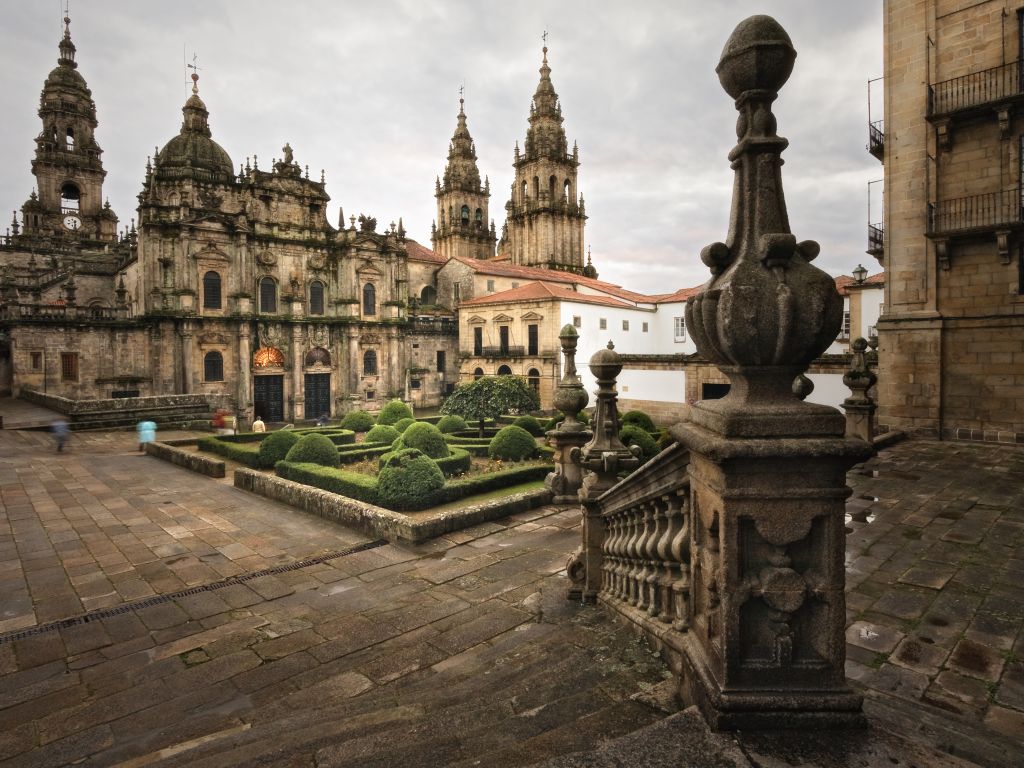


The City
In the northwest of Spain, in the green and welcoming heart of Galicia, lies Santiago de Compostela, a city that shines with history, art and tradition. Its origins date back centuries, when it became the destination of the Pilgrims' Roads to Santiago de Compostela, Europe's most important pilgrimage, cultural and tourist destinations. Today, Santiago continues to be a beacon for travelers from all over the world seeking to immerse themselves in a rich culture and a uniquely beautiful environment.
A city with history and soul
Santiago de Compostela is more than the capital of Galicia; it is a living museum. It has witnessed countless historical events that have left their mark on its cobblestone streets and impressive architecture. The majestic Cathedral of Santiago, a masterpiece of Romanesque and Gothic art, stands in the center of the city as a testament to the religious fervor and artistic splendor of the Middle Ages. This magnificent building is the destination of the legendary St. James' Way (Camino de Santiago), a network of pilgrimage routes throughout Europe, which attracts hundreds of thousands of pilgrims worldwide each year seeking to complete their spiritual or cultural journey.
Architecture that tells stories
Strolling through Santiago de Compostela is like flipping through the pages of an architectural history book. From the grandeur of the Obradoiro Square, with the Cathedral dominating the scene, to the narrow streets of the old town, declared a UNESCO World Heritage Site in 1985, the city offers an impressive mix of architectural styles. Stone buildings with slate roofs, medieval cloisters and lively squares tell the story of the evolution of a city that has managed to preserve its ancient charm without renouncing modernity.
An epicenter of knowledge and know-how
In addition to being a place of pilgrimage, Santiago de Compostela is an important educational center. The University of Santiago de Compostela, one of the oldest in Spain, founded in 1495, is a fundamental pillar of the cultural and academic life of the city.
With a wide range of studies and a vibrant student community, the university contributes to the dynamism and vitality of Santiago, making the city a place where knowledge and innovation flourish.
The University is home to 25,000 undergraduate students and more than 3,000 doctoral students. Research and Technological Development is one of the most important activities of USC with more than 250 research teams providing high quality scientific output in all areas. Labelled by the Spanish Government as a Campus of International Excellence its Campus Vida initiative defines and contributes to the development of a new model of sustainable economic and social growth based on talent, innovation and internationalization.
Gastronomy: A journey between tradition and modernitySantiago's cuisine, deeply rooted in Galician tradition, is characterized by the use of fresh, high quality ingredients from Galicia's rich land and generous sea. Local fishing and agriculture are the pillars of a gastronomy that celebrates the authenticity and natural flavor of the products.
Emblematic traditional dishes such as octopus cooked "á feira" style or pie ("empanada") are joined by other elaborations that are the result of gastronomic creativity.
The city has welcomed a new generation of chefs who, inspired by Galician roots, experiment and reinterpret traditional flavors with modern techniques and innovative presentations. This fusion of tradition and modernity is also reflected in the growing offer of gastronomic experiences in Santiago. Markets such as the "Mercado de Abastos," with more than 300 years of history, not only offer fresh produce, but also host spaces where chefs prepare dishes directly with the ingredients purchased, creating a real-time culinary experience. We cannot forget the "Tarta de Santiago", an exquisite almond-based dessert that is a true emblem of the city.
Trade and tradition in every corner
Commerce in Santiago de Compostela is a mixture of tradition and modernity. In its markets and stores, you can find high quality local products, from handicrafts to fashion and gourmet products. The shopping streets of the old town are full of small family businesses that offer personalized attention and unique products that reflect the essence of Galicia. Here, visitors can take a little piece of Santiago home with them, whether in the form of a handcrafted souvenir or a delicious sample of the local gastronomy.
Climate
The humid oceanic climate guarantees mild temperatures throughout the year. The average annual temperature is around 15ºC, with an average of 8ºC in winter and a pleasant summer with temperatures ranging between 20 and 27ºC. Most of the rain falls in winter, with variable amounts in spring and autumn.
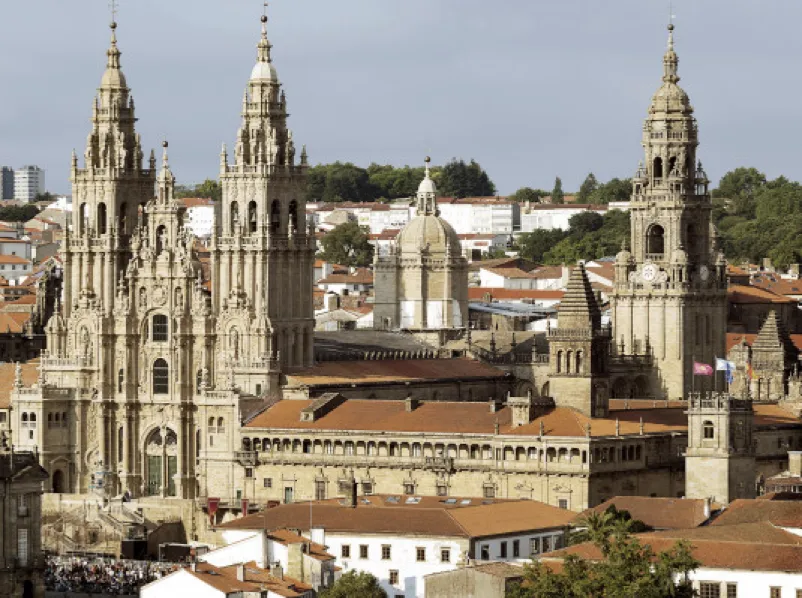



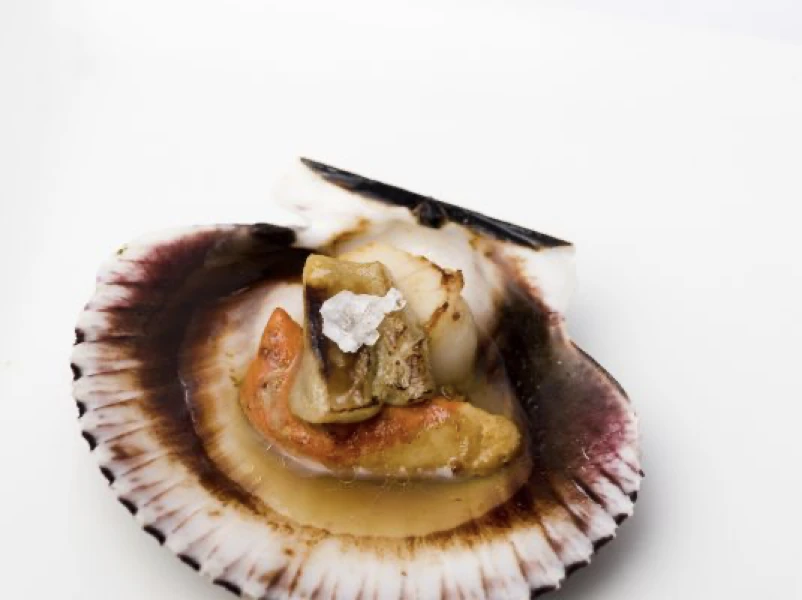
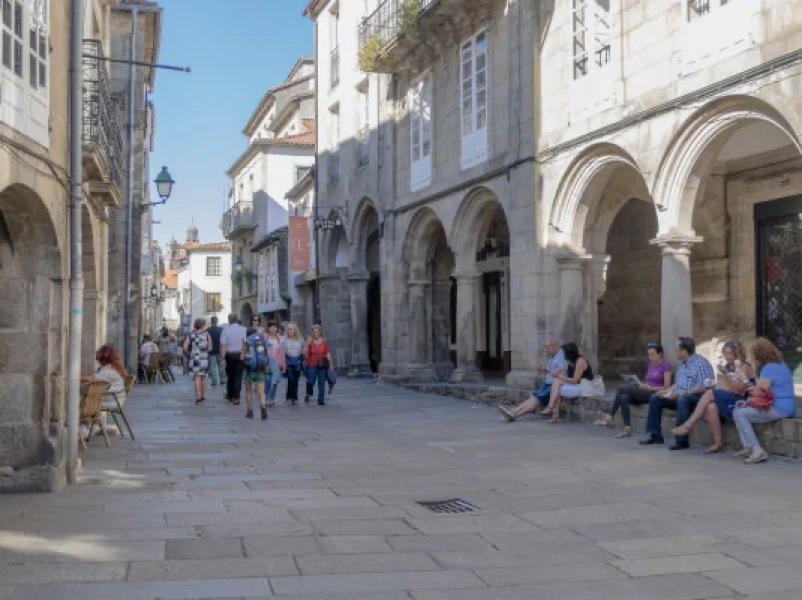
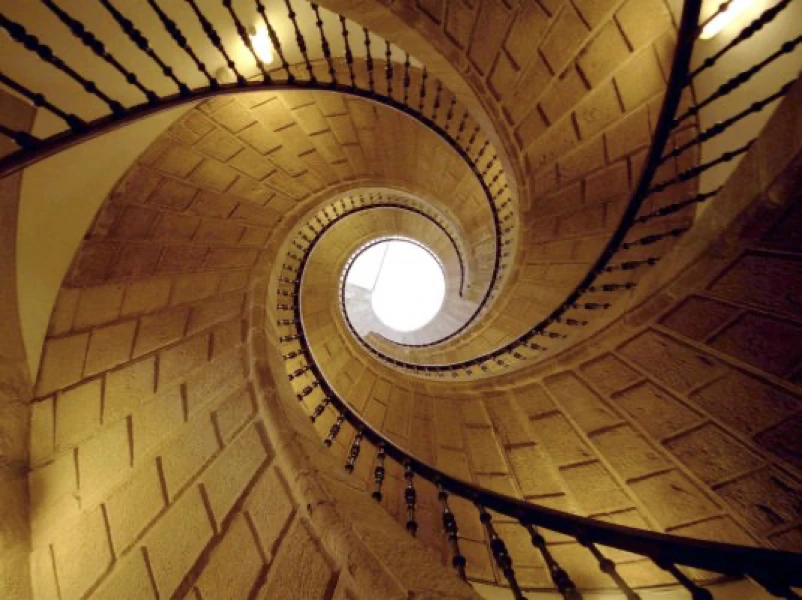
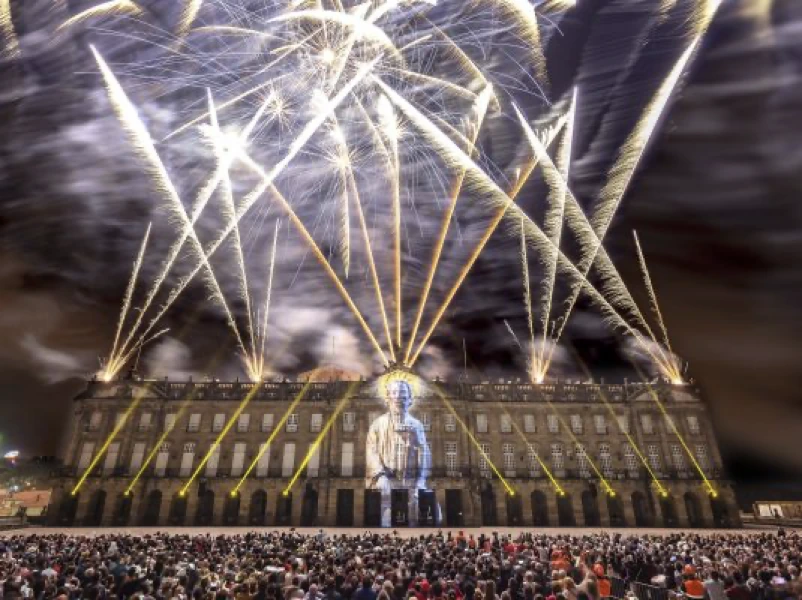
HOW TO GET THERE
By plane
Santiago de Compostela "Rosalía de Castro" Airport (SCQ)
Lavacolla International AirportThe airport is reached either via the N-634 road or the A-54 dual carriageway.
Airlines operating out of Lavacolla Airport
- By car: Distance 10 km (20 min.)
- By bus: Lavacolla Airport-Santiago Intermodal Station: 6A City Bus / Company Monbus
- Airport-City Centre buses:: 6A City Bus / Company Monbus
- Taxi: Radio-Taxi (24 h). Contact: +34 981 56 92 92 - Radiotaxicompostela
A Coruña Airport (LCG)
AlvedroAirlines operating out of A Coruña Airport
- By car: Distance to Santiago 69 km (51 min.)
- By bus: A Coruña Airport - Santiago Airport:Company Monbus
- By train: A Coruña (city) - Santiago Intermodal Station:RENFE
Vigo Airport (VGO)
PeinadorAirlines operating out of Vigo Airport
- By car: Distance to Santiago 93,9 km (1 h. 30 min.)
- By bus: Vigo (city) - Santiago Intermodal Station:Company Monbus
- By train: Vigo (city) - Santiago Intermodal Station:RENFE
Porto Airport (OPO)
Maia (Portugal)- By car: Distance to Santiago 227 km (2 h. 20 min.)
- By bus: Porto Airport - Santiago:Company Alsa / Company Flixbus
By train
Santiago de Compostela Intermodal Station
Hórreo, 75 A+34 902 320 320
High-speed (AVE):
direct daily high-speed trains link up with Madrid and other cities in Spain (Barcelona, Valencia, Sevilla…).Average duration Madrid-Santiago:
3 hours 30 minutesLong-distance and regional trains:
other long-distance trains link up with nearly all of Spain's main cities on a daily basis. There are also regional trains approximately every hour to the main destinations in Galicia (A Coruña, Vilagarcía de Arousa, Pontevedra and Vigo)
By bus
Santiago de Compostela Intermodal Station
Rúa Clara Campoamor+34 981 542 416
Long-distance Routes - Alsa:
Connections with Spanish cities and international connections: Porto (Airport), Paris...
Routes: Alsa
Long-distance Routes - Flixbus:
Connections with Spanish cities and international connections: Porto (Airport), Paris...
Routes: Flixbus
By car
Atlantic Motorway AP-9:
Links Santiago de Compostela with other Galician locations (A Coruña, Ferrol, Pontevedra, Vigo, Tui) and Portugal (Porto, Lisbon).
A-6 and A-52 Motorways:
Link Galicia with the rest of Spain via Lugo and Ourense respectively.
A-8 Motorway:
Links Galicia with France via the Northern Cantabrian coast.
GETTING AROUND IN THE CITY
Santiago de Compostela is a city with a simple structure. Its center is the so-called "casco histórico" (old town), which corresponds roughly to the area that used to be surrounded by 11 th -century walls. This term is also applicable to some areas surrounding this large monumental quarter, since they are included in the City Council's protection, conservation and rehabilitation plan.
The old town is home to an important number of monuments that can be visited, intensive shopping numerous accommodation and gastronomic establishments, as well as institutions, museums, foundations and the oldest buildings belonging to the University of Santiago. There are also houses, markets, cafés and bars, which make it a lively, dynamic area.
Its main streets or "rúas" (Franco, Vilar and Nova), of medieval origin, run parallel to each other from the surroundings of O Toural square towards the squares surrounding the Cathedral: Obradoiro, Praterías and Quintana, respectively. Crossing Obradoiro square northwards takes us to Rúa de San Francisco, which leads to the Xoán XXIII Coach Terminus and the University's North Campus. Another "rúa" parallel to Vilar and Nova streets, called Caldeirería (which begins in O Toural square with the name of Orfas and leads to Cervantes square as Rúa do Preguntorio), is one of the main shopping streets, the same as Algalia de Arriba and Algalia de Abaixo, which run northwards from the latter square. From Cervantes it is very easy to find the Food Market. And since it is part of the city route followed by pilgrims towards the Cathedral, the writer's square is also a good starting point (walking in the opposite direction to the pilgrims along Rúa das Ánimas and Casas Reais) to reach Porta do Camiño and, from there, the cultural complex of Bonaval. In the surroundings, centred on important convents and churches, there are traditional city neighbourhoods such as Sar, to the southeast, Belvís or San Pedro.
The former location of one of the city gates, Porta Faxeira, is the natural access from the old town to the Alameda. This city park, which is surrounded by the monumental quarter, the "Ensanche" (urban expansion area) and the University's South Campus is also the starting point of an interesting route around Compostela's green spaces which goes around the outskirts of the old town, providing magnificent views of its monuments and touring some of the city's most outstanding works of contemporary architecture.
This same Porta Faxeira (as well as another former gate called Porta da Mámoa, near Rúa das Orfas) also leads to the "Ensanche". This is the name given to the city's first urban expansion area, which was built in the early 20 th century to the south of the old town. It is limited by Castrón Douro street to the east, Romero Donallo avenue to the south and Rosalía de Castro avenue to the west.
The Ensanche's main streets are Hórreo (which runs between Galicia square, passing by the Galician Parliament and the Renfe Train Station); and the ones running parallel to it, Doutor Teixeiro, Xeneral Pardiñas and Alfredo Brañas. These streets and the neighboring ones, most of which are one-way streets, form an area combining residential flats with a variety of busy shops, hotels, restaurants and lively nightlife from Thursday to Saturday.
City map and tourist information
The official city map is one of the most popular tourist publications of the city; it lists all points of interest, monuments and basic services, and suggests three general routes for touring around Santiago.
Map of Santiago de Compostela
For further tourist information about Santiago de Compostela, please visit: www.santiagoturismo.com
Emergency Telephone Numbers
- General emergencies (24 h.): 112
- Fire Brigade: 080
- Civil Guard: 062
- Forest Fires: 085
- Local Police: 092
- National Police: 091
VISA
As a part of the European Union, Schengen Borders Code apply to travellers coming to Spain. Therefore, ECAI 2024 attendees are kindly asked to check well in advance the entry requirements with their local authorities or the closest embassy/consulate of Spain in their countries of residence.




















